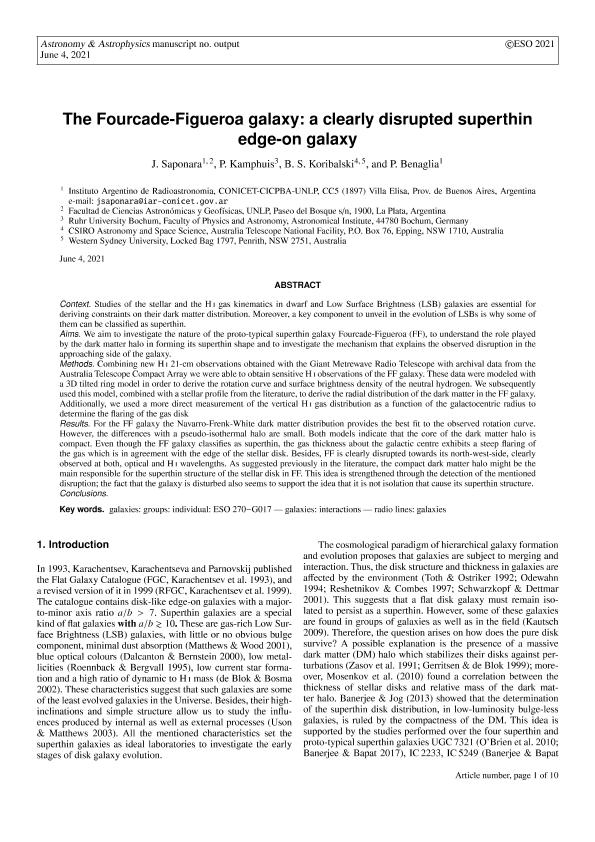Artículo
Fourcade-Figueroa galaxy: A clearly disrupted superthin edge-on galaxy
Fecha de publicación:
07/2021
Editorial:
EDP Sciences
Revista:
Astronomy and Astrophysics
ISSN:
0004-6361
Idioma:
Inglés
Tipo de recurso:
Artículo publicado
Clasificación temática:
Resumen
Context. Studies of the stellar and the HI gas kinematics in dwarf and Low Surface Brightness (LSB) galaxies are essential for deriving constraints on their dark matter distribution. Moreover, a key component to unveil in the evolution of LSBs is why some of them can be classified as superthin.Aims. We aim to investigate the nature of the proto-typical superthin galaxy Fourcade-Figueroa (FF), to understand the role played by the dark matter halo in forming its superthin shape and to investigate the mechanism that explains the observed disruption in the approaching side of the galaxy.Methods. Combining new H i 21-cm observations obtained with the Giant Metrewave Radio Telescope with archival data from theAustralia Telescope Compact Array we were able to obtain sensitive HI observations of the FF galaxy. These data were modelled with a 3D tilted ring model in order to derive the rotation curve and surface brightness density of the neutral hydrogen. We subsequently used this model, combined with a stellar profile from the literature, to derive the radial distribution of the dark matter in the FF galaxy.Additionally, we used more direct measurement of the vertical HI gas distribution as a function of the galactocentric radius to determine the flaring of the gas diskResults. For the FF galaxy, the Navarro-Frenk-White dark matter distribution provides the best fit to the observed rotation curve.However, the differences with a pseudo-isothermal halo are small. Both models indicate that the core of the dark matter halo is compact. Even though the FF galaxy classifies as superthin, the gas thickness about the galactic centre exhibits a steep flaring of the gas which is in agreement with the edge of the stellar disk. Besides, FF is clearly disrupted towards its northwest-side, clearlyobserved at both, optical and HI wavelengths. As suggested previously in the literature, the compact dark matter halo might be the main responsible for the superthin structure of the stellar disk in FF. This idea is strengthened through the detection of the mentioned disruption; the fact that the galaxy is disturbed also seems to support the idea that it is not isolation that causes its superthin structure.
Palabras clave:
galaxies: groups: individual: ESO 270−G017
,
galaxies: interactions
Archivos asociados
Licencia
Identificadores
Colecciones
Articulos(IAR)
Articulos de INST.ARG.DE RADIOASTRONOMIA (I)
Articulos de INST.ARG.DE RADIOASTRONOMIA (I)
Citación
Saponara, Juliana; Kamphuis, P.; Koribalski, Bärbel; Benaglia, Paula; Fourcade-Figueroa galaxy: A clearly disrupted superthin edge-on galaxy; EDP Sciences; Astronomy and Astrophysics; 652; A108; 7-2021; 1-10
Compartir
Altmétricas




